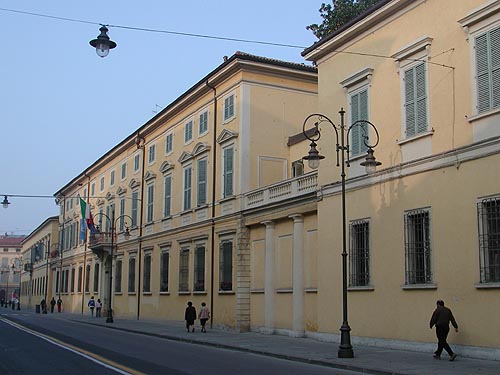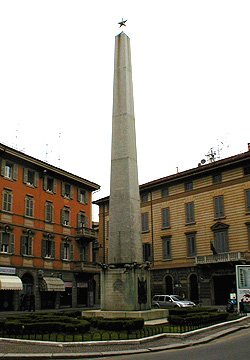 |
 |
 |
 |
 |
 |
 |
 |
 |
|
A Jacobite Gazetteer - Italy
Reggio Emilia |
|
The town of Reggio is located 30 kilometres west of Modena. King James III and VIII stopped in the town March 11, 1717, on his way from Turin to Pesaro. 1 He was the guest of Count Bergami. 2 Palazzo Salvador AllendePalazzo Salvador Allende (formerly Palazzo Ducale) is located on the west side of the city at Corso Giuseppe Garibaldi 57-59. It is immediately across the street from the Basilica della Madonna della Ghiara. In 1814 the city presented this palace to Duke Francis IV of Modena (husband of Queen Mary III and II) to serve as his residence in Reggio. Over the next fifty years many members of the Royal Family visited the town and stayed here. The Royal Family often came to Reggio in May, and attended the local theatre for which the town was famous.
Queen Maria Teresa visited the town June 9, 1821, and May 25, 1825, while her husband King Victor visited November 1, 1822. 3 The visits of Queen Mary III and II, King Francis I, and their families are very numerous. 4 Today Palazzo Allende houses the offices of the Province of Reggio Emilia and the Prefettura of Reggio Emilia.
Obelisk in Piazza GiobertiIn 1842 the piazza at the northern end of Corso Giuseppe Garibaldi, just north of Palazzo Ducale, was named Piazza Adelgonda in honour of Queen Adelgunde (wife of King Francis I); it was renamed Piazza Gioberti in 1859. When Francis and Adelgunde visited Reggio in May 1842, Piazza Adelgonda was decorated with arches, obelisks, and Chinese pagodas for the occasion. 5 In 1843 a granite obelisk designed by Pietro Marchelli was erected in the middle of the piazza in honour of Francis and Adelgunde. 6 The obelisk is 17.75 metres high and is surmounted by a five-pointed gilt metal star. Originally there were two inscriptions by Abate Tarasconi at the base of the obelisk.7 In May 1882 the city council ordered that these be altered to the present inscription: |
|
QUESTO MONUMENTO ERETTO PER LE NOZZE DI FRANCESCO V. D'ESTE CON ADELGONDA DI BAVIERA FU PER VOTO DI POPOLO CONSACRATO AI PRIMI MARTIRI DELLA LIBERTÀ MDCCCXLII - MDCCCLXXXII |
This monument, erected for the marriage of Francis V of Este with Adelgunde of Bavaria, was, by the vote of the people, dedicated to the first martyrs of liberty, 1842 - 1882. |
|
Museo del TricoloreThe Museo del Tricolore is dedicated to the history of the three-coloured flag of the republican movement. It is located in the Palazzo del Municipio in Piazza Camillo Prampolini (the main square of the town). In 2005 the museum opened a new section dedicated to the Risorgimento (the unification of Italy). On the first floor of the musuem is a portrait of Duke Francis IV of Modena (husband of Queen Mary III and II). He is dressed in the uniform of an officer of the Austrian Army with the red and green sash of the Order of Saint Stephen of Hungary. Around his neck he wears the badge of the Order of the Golden Fleece. On his breast he wears the stars of three orders of chivalry.
On the second floor of the museum is a second portrait of Duke Francis IV of Modena. He is dressed in the uniform of an officer of the Austrian Army. Around his neck he wears the badge of the Order of the Golden Fleece. The youth of the subject suggests that the portrait was painted before Francis was restored to the duchy of Modena in 1814.
Also on the second floor of the museum is a portrait of King Francis I by Adeodata Malatesta. 8 He is dressed in the uniform of an officer of the Austrian Army with the red and green sash of the Order of Saint Stephen of Hungary. Around his neck he wears the badge of the Order of the Golden Fleece. On his breast he wears the star of an order of chivalry. Around his shoulders is an ermine cape. The portrait is very fine and, judging by the youth of the subject, was probably commissioned to celebrate Francis' succession as duke of Modena. The portrait is, however, also rather peculiar. It appears to have been painted as a mirror-image; usually the star would be on the opposite side and the sash would be worn over the other shoulder.
The museum is open Tuesday to Friday from 9.00 a.m. to 12.00 noon, and Saturdays and Sundays from 10.00 a.m. to 1.00 p.m. and from 3.00 p.m. to 7.00 p.m. Website: www.tricolore.it; telephone 0522 456805. Notes 1 Cf. "Festeggiamenti per l'arrivo di Giacomo III Re di Gran Bretagna", Estratto del Diario di Bernardino Rosati a della Cronaca di Antonio Denaglia, Biblioteca Municipale di Reggio Emilio, Manoscritti reggiani C 155, c. 12r (cited by Maria Cristina Bulgareli and Mara Zarotti, "Feste e Spettacoli nelle Cronache Cittadine (1515-1851)" in Sergio Romagnoli and Elvira Garbero, Teatro a Reggio Emilia (Firenze: Sansoni, 1980), I, 282). 2 Peggy Miller, A Wife for the Pretender (New York: Harcourt, Brace & World, 1965), 21. 3 Prospero Fantuzzi, Cronaca di Reggio nell'Emilia per gli anni 1820-1858, Biblioteca Municipale di Reggio Emilio, Manoscritti reggiani C 132, pages 11, 28-29, and 58 (cited by Bulgareli and Zarotti, I, 287-288). 4 Cf. Bulgarelli and Zarotti, I, 286-296. 5 Teodoro Bayard de Volo, Vita di Francesco V, Duca di Modena, 1819-1875 (Roma: Spithover, 1878), I, 115. Cf. "Festeggiamenti per l'arrivo del Sovrano con la Duchessa Adelgonda di Baviera" in Filippo Braglia, Memorie di quanto accadde in Reggio e nella Provincia, Biblioteca Municipale di Reggio Emilio, Manoscritti reggiani C 118, fascicolo V, 6 (cited by Bulgareli and Zarotti, I, 292). 6 Bayard de Volo, I, 112, and IV, 455. Walter Baricchi, Il Palazzo Ducale (Reggio Emilia: Technograf), 27. Cf. Archivio di Stato di Reggio Emilia, Domenico Marchelli, Progetto del Monumento da esigersi nella Strada detta della Ghiara. 7 Baricchi, 27. Cf. Biblioteca Municipale di Reggio Emilia, P. Fantuzzi, Memorie delle cose più rimarchevoli che accadute sono giornalmente nella nostra città di Reggio, vol. I, 1820-1836. 8 Adeodata Malatesa was born in Modena in 1806 and died in the same city in 1891. Between 1834 and 1852 he painted a number of portraits of different members of the Royal Family as well as paintings on other subjects for the Royal Family. Image 1 (Palazzo Ducale): unknown source. Image 2 (Piazza Gioberti): © Noel S. McFerran 2004. Image 3 (Duke Francis IV of Modena): © Noel S. McFerran 2007. Image 4 (Duke Francis IV of Modena): © Noel S. McFerran 2007. Image 5 (King Francis I): © Noel S. McFerran 2007. |
|
This page is maintained by Noel S. McFerran (noel.mcferran@rogers.com) and was last updated January 15, 2009. |




